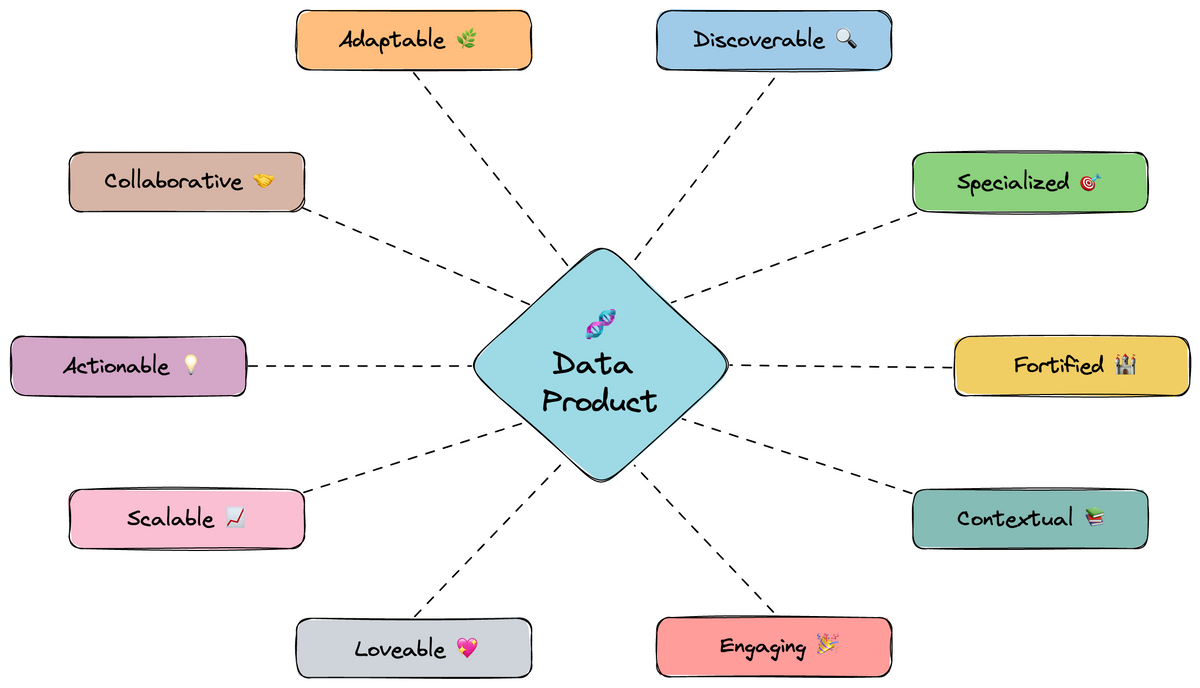10 Key Elements for Creating Successful Data Products: Data Product Anatomy
Master the art of data product creation with 10 key elements: Adaptable, Specialized, Discoverable & more! 🚀🌟

🚀 Greetings, data enthusiasts! Kevin here, and today we're going to delve into the fascinating world of data products. In this age of information, data is an invaluable asset, and effectively utilizing it can set your organization apart from the competition.
So, let's dive right in and examine the essential components for creating successful data products that not only achieve your business objectives but also engage your users. Without further ado, let's embark on a journey to explore the anatomy of data products and the 10 key elements that will help you understand and build impactful data products
🤔 Data Product vs. Data As A Product: What's the Difference?
🧬 Data Product
A data product is any technological product or element that relies on data to achieve its primary purpose. Think of it as a tool that uses data to solve problems and provide insights.
📱 Data As A Product
Now, "data as a product" is when you treat data itself as a valuable commodity. It's like transforming data into a shiny new gadget that your customers (or internal team members) want to get their hands on. This approach helps democratize data by making it more accessible, usable, and valuable to everyone in the organization.
👉 Remember: a "data product" uses data to achieve its goal, while "data as a product" means data is the actual product being offered. Data as a product is a subset of a data product. Applying product thinking to data management.
Now that we've got that cleared up, let's move on to the main event!
🧬 10 Key Elements of Data Products
1. Adaptable 🌿
To create a successful data product, it should be adaptable and seamlessly integrate with various inputs and outputs. It should effortlessly expand to accommodate new data sources and adapt to changing user needs. For instance, a data product should have the ability to connect with different databases and platforms, ensuring its usability across multiple systems.
2. Discoverable 🔍
Make your data product easily found and accessible without being hidden or restricted. Users should be able to locate it quickly and understand how it can benefit them. This includes having clear documentation, intuitive navigation, and easy-to-understand metadata.
3. Specialized 🎯
A successful data product must address a focused set of valuable problems for external customers. By having a clear purpose, the product can be designed to effectively solve these specific problems. This ensures that the data product remains relevant, efficient, and valuable to its users.
4. Fortified 🏰
Security and stability are crucial for any data product. Your product should ensure reliable data handling and protect sensitive information. This includes having strong access controls, data governance rules, and thorough testing to ensure data integrity and security are enforced.
5. Contextual 📚
A successful data product should maintain a historical record of its purpose and problem-solving context, including a data dictionary and external references. This helps users understand the data product's history and evolution, making it easier for them to trust and use it effectively.
6. Engaging 🎉
To capture the interest of your target audience, your data product should provide relevant and valuable insights. This can be achieved through interactive visualizations, easy-to-understand reports, and personalized recommendations. By making your data product engaging, you'll encourage users to interact with it more frequently and derive greater value from it.
7. Loveable 💖
A successful data product should exceed the minimum loveable product standard, making it approachable and user-friendly. This means prioritizing usability, design, and overall user experience. By creating a product that users enjoy using, you'll increase adoption and drive success.
8. Scalable 📈
A successful data product should be designed with scalability in mind. As your user base grows or your data volume increases, your data product should be able to handle the increased workload without compromising performance or functionality. This includes considering the infrastructure, data processing, and storage requirements needed to support your data product in the long term.
9. Actionable 💡
Your data product should provide insights that drive decision-making and enable users to take action based on the information it provides. The key is to present data in a way that helps users make informed decisions, whether that's through clear visualizations, relevant metrics, or user-friendly interfaces. By making your data product actionable, you'll empower your users to leverage the insights it provides effectively.
10. Collaborative 🤝
A successful data product should promote collaboration among its users, encouraging them to share insights, discuss findings, and work together towards common goals. This can be achieved by integrating features such as comments, annotations, or sharing options within the data product. By fostering a collaborative environment, your data product will become a valuable tool that helps your users work together more effectively.
🌟 Real-life Data Product Examples
🎬 Netflix: Adaptable, Engaging, and Loveable
Netflix has transformed the way we consume entertainment with its data-driven recommendation engine. By analyzing user preferences and viewing history, Netflix provides personalized content suggestions to keep users engaged. The platform seamlessly adapts to new data inputs, such as user behavior, content availability, and device usage, to enhance its recommendations. Netflix's engaging user interface and easy-to-use features make it a loveable data product that keeps users coming back for more.

🧠 Einstein AI (Salesforce): Specialized, Fortified, and Contextual
Einstein AI is Salesforce's artificial intelligence solution that offers specialized data products tailored to various industries and use cases. By leveraging machine learning algorithms and natural language processing, Einstein AI enables organizations to automate processes, gain insights, and make data-driven decisions. The platform is fortified with robust security features, ensuring data protection and compliance. Additionally, Einstein AI maintains context by integrating with Salesforce's extensive ecosystem, allowing users to seamlessly access relevant data and insights.

🏠 Airbnb: Adaptable, Fortified, and Loveable
Airbnb revolutionized the short-term rental market with its data-driven dynamic pricing algorithm. This data product helps hosts optimize their rental prices based on factors such as location, demand, and seasonality. The algorithm continuously adapts to market conditions and user preferences, providing accurate pricing suggestions to maximize revenue for hosts. Airbnb prioritizes data security to protect user information and offers a loveable, user-friendly interface that appeals to both hosts and guests.

Conclusion 🚀
Creating successful data products requires a deep understanding of the product's anatomy and how it fits within your organization's ecosystem. By considering the key factors discussed above, you'll be well on your way to developing data products that not only achieve your business objectives but also delight your users. Remember, successful data products are adaptable, specialized, discoverable, fortified, contextual, engaging, loveable, scalable, actionable, and collaborative! Good luck! 🌟
